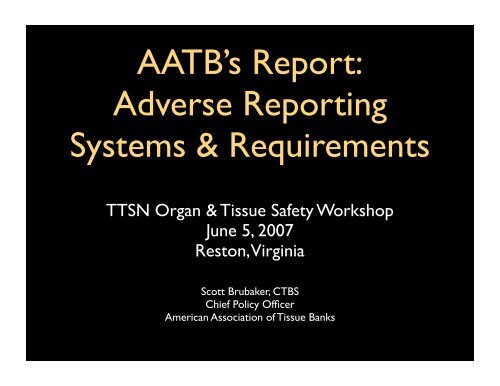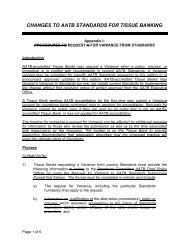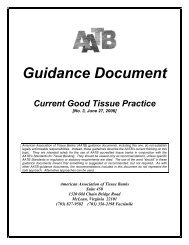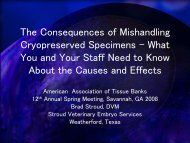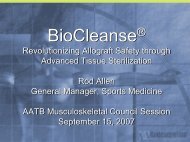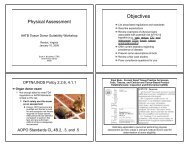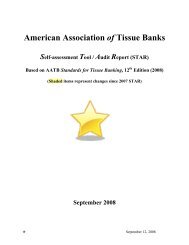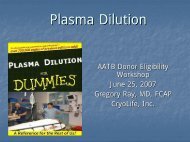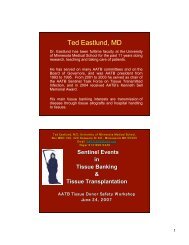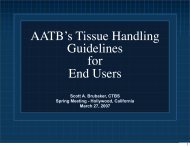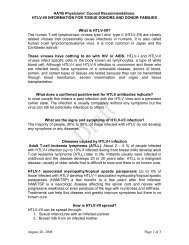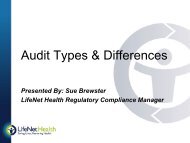Scott Brubaker - American Association of Tissue Banks
Scott Brubaker - American Association of Tissue Banks
Scott Brubaker - American Association of Tissue Banks
You also want an ePaper? Increase the reach of your titles
YUMPU automatically turns print PDFs into web optimized ePapers that Google loves.
AATB’s Report:<br />
Adverse Reporting<br />
Systems & Requirements<br />
TTSN Organ & <strong>Tissue</strong> Safety Workshop<br />
June 5, 2007<br />
Reston, Virginia<br />
<strong>Scott</strong> <strong>Brubaker</strong>, CTBS<br />
Chief Policy Officer<br />
<strong>American</strong> <strong>Association</strong> <strong>of</strong> <strong>Tissue</strong> <strong>Banks</strong>
Current Practices<br />
• Adverse event/reaction/outcome reporting<br />
requirements<br />
❖<br />
❖<br />
❖<br />
Federal, State, International<br />
AATB Standards & Accreditation Policy<br />
Investigation Practices - Flowchart<br />
• Definitions<br />
❖<br />
Possible, Probable, Proven, Indeterminate, or<br />
Excluded<br />
• Implant Card Experience Tracking
Reporting Requirements<br />
• Federal - refer to Melissa’s excellent presentation!<br />
• State<br />
❖ New York - Title 10 NYCRR Part 52; and subparts 52-2<br />
Licensure, 52-3 General Technical<br />
๏<br />
๏<br />
๏<br />
๏<br />
Covers tissue banks & transplant centers<br />
Adverse outcome reporting & records required for<br />
transplant centers<br />
Required reporting by tissue banks (within 7 calendar days)<br />
<strong>of</strong> “Errors and Accidents” if grafts distributed; relates to<br />
reporting above by transplant center<br />
Must submit annual activity reports (provides denominator)
Reporting Requirements<br />
• State (continued)<br />
❖<br />
๏<br />
Florida (AHCA)<br />
Requires tissue bank to report ALL potential adverse<br />
reactions using Part 1 <strong>of</strong> Adverse Reaction Report<br />
✴<br />
✴<br />
Only required when the report is made to the tissue bank by<br />
the transplanting physician or hospital<br />
Required within one working day<br />
๏<br />
After investigation by tissue bank, then requires<br />
reporting using Part 1I <strong>of</strong> Adverse Reaction Report<br />
✴<br />
Required when investigation concluded<br />
๏<br />
AHCA not involved in investigations
Reporting Requirements<br />
• International<br />
❖<br />
๏<br />
Canada<br />
Proposed CTO Regulations<br />
❖<br />
๏<br />
๏<br />
๏<br />
✴<br />
Report all adverse reactions within 24 hrs to Health Canada<br />
and provide updates ever 30 days<br />
Medical Device Reporting Schemes<br />
EU Authorities - Medical Device Vigilance<br />
Canada - Therapeutic Products Program<br />
Australia - Therapeutic Goods Act<br />
๏<br />
Japan - Adverse Reaction Reporting
AATB Standards<br />
• 1984 (1st Edition) - must<br />
maintain an adverse<br />
reaction file; recall<br />
procedures must exist<br />
• 1993 (6th edition) - new<br />
standards for “Medical<br />
Facility <strong>Tissue</strong> Storage and<br />
Issuance” requires<br />
adverse outcome<br />
reporting to tissue bank<br />
& recall procedures must<br />
be written
AATB Standards<br />
• 1996 (7th edition) - requires<br />
<strong>Tissue</strong> Distribution<br />
Intermediaries to investigate<br />
& report adverse outcomes<br />
to tissue bank & to have recall<br />
procedures<br />
• 1998 (8th edition) - tissue<br />
bank “shall establish recipient<br />
follow-up collection<br />
protocols”<br />
❖<br />
Implant cards most <strong>of</strong>ten<br />
used
AATB Standards<br />
In A2.000 Definitions <strong>of</strong> Terms:<br />
ADVERSE OUTCOME - An undesirable<br />
effect or untoward complication in a<br />
recipient consequent to or reasonably<br />
related to cells and/or tissue<br />
transplantation.
AATB Standards<br />
In A2.000 Definitions <strong>of</strong> Terms:<br />
ERROR - A departure, whether or not intentional,<br />
from the SOPM, standards, or applicable federal, state,<br />
and/or local laws and/or regulations during donor<br />
screening, testing, retrieval, processing, quarantine,<br />
labeling, storage, distribution, or dispensing <strong>of</strong> cells<br />
and/or tissues that may cause infectious disease<br />
transmission, adversely affect the clinical performance<br />
<strong>of</strong> cells and/or tissue, and/or interfere with the ability<br />
to trace cells and/or tissue to the donor.
AATB Standards<br />
B2.200 Medical Director<br />
B2.220 Responsibilities<br />
B2.222 Adverse Outcomes<br />
The Medical Director shall establish policies and procedures<br />
regarding Adverse Outcomes and shall require that all potential<br />
Adverse Outcomes are investigated and documented.<br />
Corrective actions shall also be documented. All final<br />
summary reports shall be reviewed and approved by the<br />
Medical Director. Adverse Outcomes must be reported as<br />
required by applicable federal, state and/or local laws and/or<br />
regulations.
AATB Standards<br />
G3.000 Labeling Information<br />
G3.210 Package Insert Content<br />
11) Statement that Adverse Outcomes potentially<br />
attributable to the cells and/or tissue must be reported<br />
promptly to the tissue supplier<br />
H5.000 Recalls - General<br />
H5.400 Recalls <strong>of</strong> Transplanted <strong>Tissue</strong><br />
.....shall be handled as a potential Adverse Outcome<br />
investigation...
AATB Standards<br />
J1.000 Standard Operating Procedures Manual (SOPM)<br />
J1.200 Contents<br />
6) Quality Assurance and Quality Control.....<br />
b) Policies and procedures for the investigation,<br />
documentation, and reporting <strong>of</strong> Accidents, Errors,<br />
Complaints, and Adverse Outcomes (Ref. Section K4.000);<br />
J1.600 Annual Review<br />
The Director or designee shall perform and document an annual review<br />
<strong>of</strong> all policies and procedures. The Medical Director shall perform and<br />
document an annual review <strong>of</strong> the SOPs for Donor suitability and<br />
Adverse Outcomes.
AATB Standards<br />
K1.000 QUALITY ASSURANCE PROGRAM<br />
K4.000 INVESTIGATIONS<br />
The QA Program shall provide for the completion <strong>of</strong> the<br />
investigation <strong>of</strong> Accidents, Errors, Complaints, and Adverse<br />
Outcomes. The QA Program, in conjunction with the Director<br />
or Medical Director, shall approve corrective actions prior to<br />
implementation. Precipitating events, recommendations, and<br />
Resolutions shall be documented in a summary report by the<br />
staff involved and reviewed for completeness and Resolution by<br />
the QA Program. All reports generated shall be retained on<br />
file for 10 years.
AATB Standards<br />
K1.000 QUALITY ASSURANCE PROGRAM<br />
K4.200 Complaints<br />
All written and oral Complaints regarding cells and/or tissue quality,<br />
Safety, packaging, or effectiveness shall be investigated to determine<br />
whether the Complaint is related to an Error, Accident, Adverse<br />
Outcome, or other factor. Each investigation shall determine whether<br />
associated cells and/or tissue may be affected. If it is determined that<br />
they may be affected, those associated cells and/or tissue shall be located<br />
and Quarantined until Resolution <strong>of</strong> the incident (which may involve<br />
initiation <strong>of</strong> a Recall). Complaints that are medical in nature shall be<br />
reviewed by the Medical Director or licensed physician designee.
AATB Standards<br />
K1.000 QUALITY ASSURANCE PROGRAM<br />
K4.300 Adverse Outcomes<br />
All reported or suspected Adverse Outcomes that are<br />
potentially related, directly or indirectly to an Allograft shall be<br />
investigated thoroughly and expeditiously. The Medical<br />
Director or licensed physician designee shall review all<br />
potential Adverse Outcome reports and be involved in<br />
determination <strong>of</strong> the impact and Resolution <strong>of</strong> any Adverse<br />
Outcome. If investigation indicates that the Adverse Outcome is<br />
related to an Error or Accident, then procedures for Error and<br />
Accidents (K4.100) shall also be followed.
AATB Standards<br />
K1.000 QUALITY ASSURANCE PROGRAM<br />
K4.310 Notifications<br />
In accordance with applicable federal, state, and local<br />
regulations, confirmed cases <strong>of</strong> transmissible disease in a<br />
Recipient attributed to cells and/or tissue transplantation shall<br />
be reported in writing in a timely fashion to public health<br />
authorities, organ retrieval organizations and <strong>Tissue</strong> <strong>Banks</strong><br />
involved in any manner with cells and/or tissue retrieved from<br />
the same donor and the physician(s) involved in the<br />
transplantation <strong>of</strong> cells and/or tissue from that donor.<br />
Notifications shall be documented in the donor’s record.
AATB Standards<br />
Section L - <strong>Tissue</strong> Dispensing Services<br />
L5.000 ADVERSE OUTCOMES<br />
Potential adverse reactions, suspected transmission <strong>of</strong> disease, or other<br />
complications, directly or indirectly related to the Allograft, shall be<br />
reported to the tissue processor and thoroughly investigated and<br />
documented.<br />
Section M - <strong>Tissue</strong> Distribution Intermediary<br />
M8.000 ADVERSE OUTCOMES<br />
Reports <strong>of</strong> Adverse Outcomes, transmitted disease, or other<br />
complications shall be reported to the supplier <strong>of</strong> the cells and/or tissue<br />
in a timely fashion and in accordance with applicable federal, state, and/<br />
or local laws and/or regulations.
AATB Accreditation<br />
Policy<br />
Since August 2004<br />
❖<br />
Required reporting to AATB<br />
Executive Office <strong>of</strong> “Reportable<br />
Contrary Events”<br />
๏<br />
Federal, state, or local actions:<br />
✴<br />
Warning Letters, recall notices, licensure<br />
change<br />
๏<br />
Recalls - voluntary or otherwise<br />
๏ Confirmed Adverse Events -<br />
contamination or disease
“Possible/Suspected” definition<br />
Regulatory Affairs/<br />
Quality Assurance<br />
Medical Director<br />
Two pathways taken during investigation
Regulatory/QA<br />
Pathway
Medical<br />
Director<br />
Pathway
“Probable” definition<br />
RA/QA Contacts<br />
Appropriate Entities<br />
“Excluded” definition<br />
needed
CAPA; Publications;<br />
Meeting Presentations<br />
“Proven” definition<br />
“Indeterminate” definition needed
Recipient Adverse Reaction<br />
Will solicit support from the end users’ pr<strong>of</strong>essional<br />
associations, then widely distribute.
“Possible” Definition
Rationale for “Possible”<br />
• Listings are manageable with reasonable<br />
sensitivity; do not desire reporting <strong>of</strong><br />
common community-acquired diseases<br />
(colds, flu, etc.)<br />
• Six-months selected (vs one year) as this is<br />
evidenced-based when investigating past<br />
tissue transmissions
Rationale for “Possible”<br />
• Positive culture or gram stain from op site<br />
or from purulent drainage all describe<br />
relevant possibilities; superficial swab results<br />
have not correlated with allografttransmitted<br />
infections<br />
• TTSN system will have pulldown menu with<br />
these signs & symptoms and laboratory<br />
findings
Rationale for “Possible”<br />
• Review <strong>of</strong> past reports in literature:<br />
❖<br />
allograft removal has not been an indicator that<br />
would capture cases<br />
❖ Recognition <strong>of</strong> symptoms occurred between 2<br />
to 113 days post op<br />
❖<br />
❖<br />
Patient re-admission within 30-days <strong>of</strong> surgery<br />
Cultured unexpected organisms from wound,<br />
drainage, or site
Probable & Proven
Indeterminate &<br />
Excluded<br />
• Not yet developed....
Implant Card Compliance<br />
2006 AATB Survey<br />
“H1.410 Responsibility - The <strong>Tissue</strong> Bank shall establish<br />
recipient follow-up data collection protocols.”<br />
• 15 tissue banks: ≈ 95% <strong>of</strong> all tissue processed in US<br />
• 100% <strong>of</strong>fer feedback opportunity<br />
❖ Content <strong>of</strong> ‘cards’ fairly uniform<br />
• Information rec’d is manually entered into a data base<br />
• 53% (8) routinely track compliance<br />
❖ Compliance range <strong>of</strong> 14% to 95%; 2/3 experience<br />
>50% compliance rate
Implant Card Compliance<br />
2006 AATB Survey<br />
“H1.410 Responsibility - The <strong>Tissue</strong> Bank shall establish<br />
recipient follow-up data collection protocols.”<br />
• Most predominant information withheld = patient<br />
identifier, MR#<br />
• End-user types most non-compliant<br />
❖ Dental <strong>of</strong>fices, oral surgeons<br />
❖ Day surgery centers (independent)<br />
❖ Large hospitals (university based)
Comments from <strong>Tissue</strong> <strong>Banks</strong><br />
• Difficulties with implant cards:<br />
❖<br />
illegible handwriting<br />
❖<br />
incomplete and/or inaccurate information<br />
• No federal requirement. Why must we close this<br />
loop, especially when compliance is not controllable<br />
• Information supplied has limited, practical use<br />
❖<br />
low return rate, data not sufficient for use during a recall or<br />
safety alert
Comments from <strong>Tissue</strong> <strong>Banks</strong><br />
• Compliance is increasing due to:<br />
❖ The Joint Commission’s <strong>Tissue</strong> Standards require it<br />
❖ End user experience with large recalls<br />
❖ Expectation is that tissue bank will track to recipient<br />
for them<br />
• Hospitals are beginning to use their own forms - this<br />
complicates the process
Thank you!<br />
(questions will be entertained at the end)


